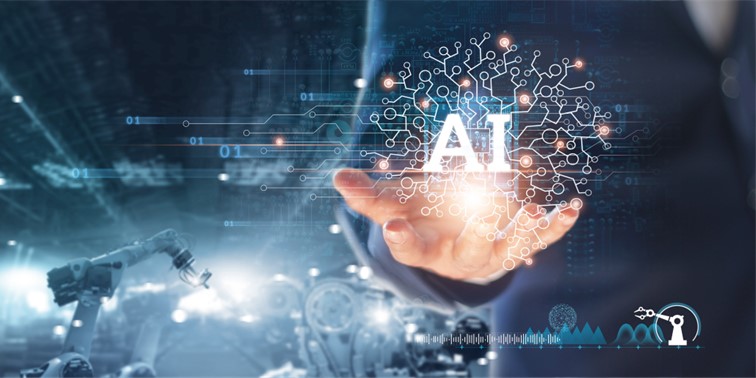The use of Artificial Intelligence (AI) in manufacturing is booming.
And new devices are enabling manufacturers to deploy it in more areas of their work than ever before.
- What is the predicted growth in AI devices?
- Where will they be used?
- How will this affect the workforce?
- And how can you prepare your operations and teams for the AI boom?
Let’s find out.
AI through the crystal ball
AI has already made many inroads into manufacturing processes. Yet, it is looking like these will become superhighways within five years. (You can find some examples of how AI is currently being used over at Robotics Business Review.)
In a recent report by ABI Research it’s claimed that AI will revolutionise the manufacturing sector, although this transformation can already be seen in many areas.
For instance, AI is already delivering significant gains for:
- Product development (via generative design)
- Inventory management (via production forecasting)
- Production (via machine vision, defect inspection, production optimisation and predictive maintenance)
It is in the numbers of devices and the scale of adoption that this revolution is predicted. ABI Research claims that the total number of installed AI-enabled devices in manufacturing will reach 15.4 million in 2024. This represents a staggering compound annual growth rate of 64.8% from 2019.
However, it seems unlikely that this growth will see AI device’s data being stored in the cloud. A spokesperson for ABI Research commented that:
‘AI in manufacturing is a story of edge implementation. Since manufacturers are not comfortable having their data transferred to a public cloud, nearly all industrial AI training and inference workloads happen at the edge, namely on device, gateways and on-premise servers.’
The technology needed to accommodate this is already in place. AI chipset manufacturers and server vendors have specifically designed servers for manufacturers to address their requirements.
Expected AI use cases
Among all the potential AI use cases it is predictive maintenance and equipment monitoring that are the most deeply embedded so far. These two use cases alone are expected to reach 9.8 million and 6.7 million devices, respectively, by 2024.
A third area that is set for growth is defect inspection, which is predicted to make a quantum leap from 300,000 devices presently to more than 3.7 million by 2024. Much of this growth is expected to come from electronic and semiconductor manufacturing.
Here machine vision offers vastly improved precision in:
- Detecting surface, leak, and component-level defects
- Microparticle detection
- Geometric measurement
- Classification
AI’s new algorithms can find unexpected product abnormalities or defects that go beyond existing discoverable issues to uncover new insights for manufacturers.
What does AI mean for the human workforce?
One thing is already clear: there is a lack of talent available to build in-house data teams for implementing AI.
The ABI report notes ‘enormous competition because most AI talents prefer to work with web-scale giants or AI start-ups, making talent acquisition a challenging task for industrial manufacturers. They are left with one viable option, which consists of partnering with other players in the AI ecosystem.’
But for many it’s not the shortage of talent that is a concern but the waste of talent.
Opinion varies wildly. Oxford Economics predicts that up to 20 million manufacturing jobs worldwide will be lost to AI by 2030, whereas the World Economic Forum estimates that automation will displace 75 million jobs but generate 133 million new ones worldwide by 2022. Meanwhile, McKinsey Global Institute suggest that there will be enough new job creation to offset the impact of automation, but Forrester sees job losses of 29% by 2030 with only 13% job creation to compensate.
Looking at what’s happening now it’s likely that there will be a period of disruption to jobs and a desperate need to upskill the workforce.
- Amazon announced earlier this year that it will spend $700 million to train about 100,000 workers in the US by 2025, helping them move into more highly skilled jobs
- A recent Dun & Bradstreet survey found that 40% percent of organizations are adding more jobs as a result of deploying AI within their business and only 8% are cutting jobs
- Mining data last year from more than 50 million job postings, ZipRecruiter found that AI created three times as many jobs as it destroyed
- Deloitte also strongly argues that ‘as organizations embrace and adopt robotics and AI, they’re finding that virtually every job can be redesigned—creating new categories of work, including hybrid jobs and “superjobs”.’
So, where does this leave us?
How can you prepare your operations and teams for the AI boom?
It appears that predictions of mass unemployment are not on the mark. But there will be talent shortages and a significant number of employees requiring retraining.
Let’s end this review of the impact of AI with a six-point programme for any organisation to deal with the changing landscape that AI will inevitably bring with it. (This has been loosely adapted from the MAPI Foundation’s ‘How AI Will Transform Manufacturing and the Workforce of the Future’.)
- Start creating teams to drive and coordinate digital transformation in your enterprise immediately
- Define a cross-departmental ‘AI team’ to specifically manage and review AI transformation progress and effects
- Their first task should be to evaluate AI and workforce transformation readiness
- Their second, to set measurable and realistic objectives for digital and AI transformation
- Look to redefine all digital and physical product innovation processes across operations
- Fully invest in communication for change management
And remember:
‘The struggle you’re in today is developing the strength you need for tomorrow.’
(Robert Tew)
